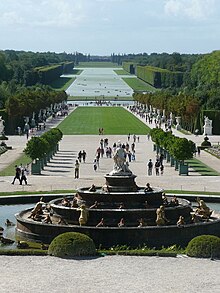Grand Canal of Versailles
At first, the French Academy of Sciences dissuaded the "King's gardener" from embarking on such an undertaking, as the terrain - a marshy area known as "étang puant" (stinking pond), which was the source of many illnesses among Versaillais[1] - was very uneven at the time.
Today, the layout of the Grand Canal takes the form of a cross, the main east-west perspective of which is located in the axis of the château and measures 1.670 kilometres (1.038 mi).
These two axes, north-south and east-west, are both 62 m (203 ft) wide and cover a surface area of 24 hectares (59 acres), for a perimeter of 5.5 km (3.4 mi), initially lined with four rows of elm trees, and embellished with statues by Jean-Baptiste Tuby, based on sketches by Charles Le Brun, depicting children and hippocampus.
When the work was completed in 1679, the Grand Canal served as the starting point for fireworks during the sumptuous royal festivities that Louis XIV organized at Versailles.
Louis XIV sailed a substantial fleet: a three-masted ship (Le Grand Vaisseau), a galley, rowboats, galiots, brigantines, gondolas (donated by the Doge of Venice) and, from 1675, two yachts from England.


